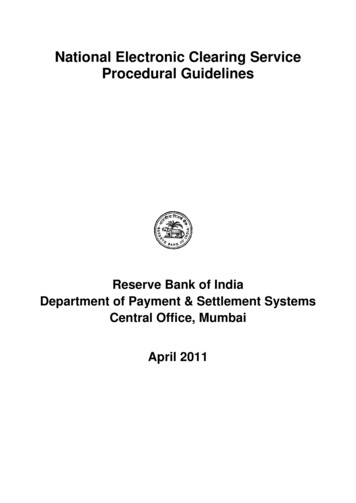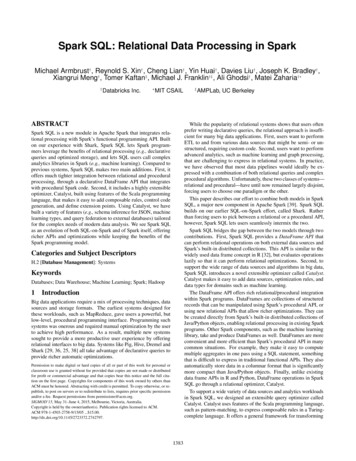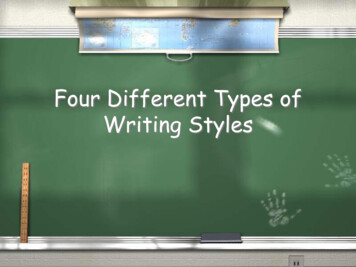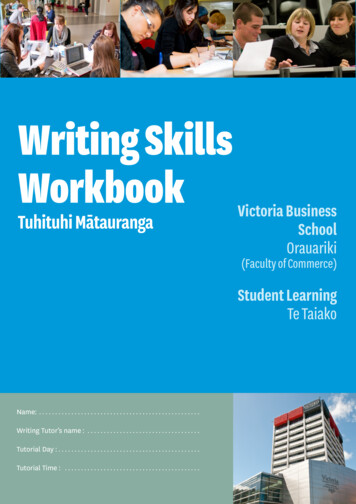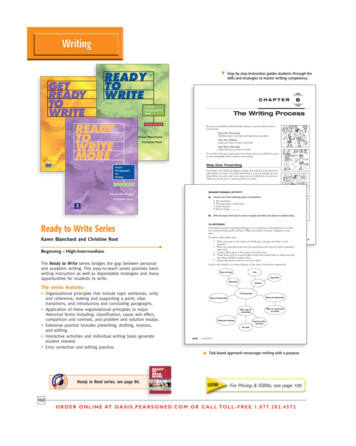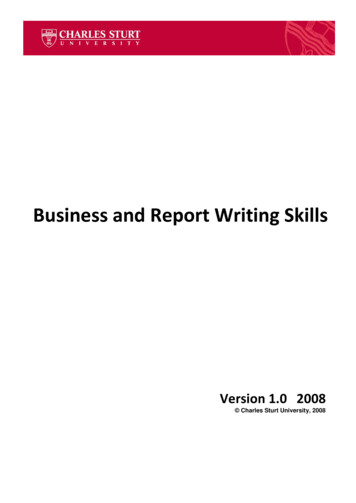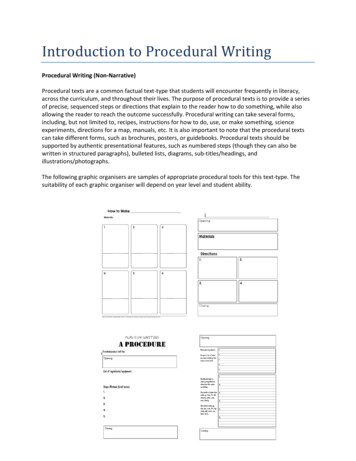
Transcription
Introduction to Procedural WritingProcedural Writing (Non-Narrative)Procedural texts are a common factual text-type that students will encounter frequently in literacy,across the curriculum, and throughout their lives. The purpose of procedural texts is to provide a seriesof precise, sequenced steps or directions that explain to the reader how to do something, while alsoallowing the reader to reach the outcome successfully. Procedural writing can take several forms,including, but not limited to, recipes, instructions for how to do, use, or make something, scienceexperiments, directions for a map, manuals, etc. It is also important to note that the procedural textscan take different forms, such as brochures, posters, or guidebooks. Procedural texts should besupported by authentic presentational features, such as numbered steps (though they can also bewritten in structured paragraphs), bulleted lists, diagrams, sub-titles/headings, andillustrations/photographs.The following graphic organisers are samples of appropriate procedural tools for this text-type. Thesuitability of each graphic organiser will depend on year level and student ability.
Student Samples – Level 1Students working within Level 1 are expected to meet criteria in some writing usually with support.Level 1c
Assessment Commentary: AF1: Ideas & Voice – Write imaginative, interesting, and thoughtful textsThe author provides four basic steps that are related to the procedure but lack elaboration and detail.The author is beginning to use pictures to express their individual writing voice; however, the author onlyincludes a picture for the first step and should be encouraged to include pictures for all steps.AF2: Organisation – Produce texts which are appropriate to task, reader, and purposeThe piece of writing does not seem to be directed to a specific audience and the author consistently refers tothe audience by using the words “you” and “your” in each step. The author is beginning to understand thepurpose of procedural writing; however, the closing they included does not suit this text-type.The author’s title directly and simply states the topic of the procedure.AF3: Organisation – Organise and present whole texts effectively, sequencing and structuringinformation, ideas and eventsThe provided scaffolding tool did not allow for the author to include an opening for this procedure. Anopening like, “Playing on an iPad is fun” would be an appropriate title for this text-type.The author is beginning to consider the materials necessary for the completion of the procedure. The basicsteps are written in sequential order, but due to a lack of elaboration, the steps seem choppy at times.The author has attempted to include a closing; however, it is a personal feeling statement and a moreappropriate closing for procedural writing, such as “Enjoy playing the iPad,” would be more suitable andwould help this author reach a higher attainment level.AF4: Organisation – Construct paragraphs and use cohesion within and between paragraphs The author uses simple, generic linking words (e.g., “first,” “next,” “then,” “finally”), but should be encouragedto use the word wall or mentor texts to spell the words correctly.The author is beginning to demonstrate an awareness of return sweep but still leaves some large spaces at theend of lines where words could fit.AF5: Sentence Fluency – Vary sentences for clarity, purpose, and effectThe author writes his/her thoughts in short, yet full sentences.The author appropriately uses simple present tense throughout the text.There is no evidence of connectives used within the text.AF6: Conventions – Write with technical accuracy of syntax and punctuation in phrases, clauses, and sentences The author does not yet demonstrate an awareness of full stops. The author accurately uses capital letters to start sentences; however, the author inappropriately uses capitalletters within sentence and words. AF7: Word Choice – Select appropriate and effective vocabularyThe author is beginning to use some adjectives in his/her writing, which is evident in step 3 when he/shedescribes the game as “special” and uses the adjective “happy” in the closing.The author is beginning to use some bossy verbs, including “open,” “find,” and “play.”The author uses simple vocabulary and high frequency words to communicate meaning but has also includedsome subject-specific vocabulary including “passcode” and “aps.”
AF8: Conventions – Use correct spellingMost high frequency words are spelled correctly (e.g., “you,” “your,” “I,” “play”) and some phoneticallyplausible attempts are made for unknown words (e.g., “opin” open, “speshol” special, “hapey” happy).The words “passcod” (passcode) and “gam” (game) demonstrate the need for additional phonics instruction ofthe “Pushy E” or “Magic E.”The author could have referred to classroom resources, such as a word wall, to help with the spelling of somehigh frequency words, but should have also been reminded to use the word wall and/or mentor texts for thecorrect spelling of linking words.AF9: Presentation - Handwriting and presentationThe author was not required to write on lines as specified in the Ministry’s handwriting policy. The authorinconsistently spaces words, particularly in the title, and can work towards using more uniform and consistentspacing between words.Where to Next? Identifying Targets for this Student: AF 6 – Using full stops appropriately at the end of each sentence will ensure this author progressesthrough Level 1 objectives. AF 3 – Including a simple, short statement related to the topic for the opening and a more suitableclosing will help the author progress.
Level 1b
Assessment Commentary: AF1: Ideas & Voice – Write imaginative, interesting, and thoughtful textsThe author provides four basic steps that are related to the procedure but lack elaboration and detail.The author is beginning to express their individuality through the inclusion of pictures for each step of theprocess, which are also becoming more detailed.AF2: Organisation – Produce texts which are appropriate to task, reader, and purposeThe piece of writing does not seem to be directed to a specific audience and the author consistently refers tothe audience by using the word “you” in each step. The author is beginning to understand the purpose ofprocedural writing.The author’s title directly and simply states the topic of the procedure.AF3: Organisation – Organise and present whole texts effectively, sequencing and structuringinformation, ideas and eventsThe scaffolding tool provided did not allow for the author to include an opening for this procedure. Anopening like “You can do a lot of things on iPads” would have been appropriate for this text-type.The author is beginning to consider the materials necessary for the completion of the procedure, but neglectsto list the main materials needed. The basic steps are written in sequential order, but due to a lack ofelaboration, the steps seem choppy at times.The author has included a short enjoyment sentence related and relevant to the process explained in theprocedure.AF4: Organisation – Construct paragraphs and use cohesion within and between paragraphs The author uses simple, generic linking words (e.g., “first,” “then,” “next,” and “finally”), but should beencouraged to use the word wall or mentor texts to spell these generic words correctly.This text cannot be used to assess the author’s understanding of return sweep as the sentence length does notrequire breaking to the next line.AF5: Sentence Fluency – Vary sentences for clarity, purpose, and effectThe author writes his/her thoughts in short, yet complete sentences.The author appropriately uses simple present tense throughout the text.There is no evidence of connectives used within the text.AF6: Conventions – Write with technical accuracy of syntax and punctuation in phrases, clauses, and sentences The author correctly uses full stops at the end of sentences and knows that full stops are not needed at theend of the title or the word “pas-word” as they are not full sentences. Most sentences start with a capital letter and the author avoids using capital letters inappropriately withinwords. AF7: Word Choice – Select appropriate and effective vocabularyThe author demonstrates a limited understanding of using adjectives in procedural writing and only effectivelyuses a simple adjective in the closing (e.g., “fun”).The author uses a variety of simple bossy verbs (e.g., “open,” “turn on,” “find,” and “play”).The author uses simple vocabulary and high frequency words to communicate meaning, but also includessome subject-specific vocabulary including “password” and “app.”AF8: Conventions – Use correct spelling
The majority of words used in the text are spelled correctly and phonetically plausible attempts are made forunknown words (e.g., “cuver” cover).The author may have referred to classroom resources, such as a word wall, to help with the spelling of somehigh frequency words, but should also be reminded to use the word wall and/or mentor texts for the correctspelling of linking words (e.g., “first,” “finally”).AF9: Presentation - Handwriting and presentationThe author was not required to write on lines as specified in the Ministry’s handwriting policy. The authorspaces words appropriately, especially in the title, but can work towards being consistent with spacingthroughout the entire text.Where to Next? Identifying Targets for this Student: AF 7 – The author should incorporate additional basic adjectives into the text to expand vocabularyand word choice. AF 5 – Using basic connectives such as “and” to connect two nouns, two adjectives, or two ideas willhelp this student reach higher levels of attainment. For example, in the closing, the student couldwrite, “Playing an iPad is fun and exciting.”
Level 1a
Assessment Commentary: AF1: Ideas & Voice – Write imaginative, interesting, and thoughtful textsThe author provides four basic steps that are related to the procedure and is beginning to include more detail(e.g., pour the milk and the syrup in the glass.)The author is beginning to express his/her individuality through the inclusion of more detailed pictures foreach step of the procedure.AF2: Organisation – Produce texts which are appropriate to task, reader, and purposeThe piece of writing does not seem to be directed to a specific audience and the author consistently refers tothe audience by using the word “you” in each step. The author is beginning to understand the purpose ofprocedural writing by giving directions to complete a procedure.The author’s title directly and simply states the outcome of the procedure.AF3: Organisation – Organise and present whole texts effectively, sequencing and structuringinformation, ideas and eventsThe author’s opening is a simple, short statement related to the product.The author includes all materials necessary for completing the procedure and is beginning to experiment withmaking a list. The basic steps are in sequential order.The author has included a short enjoyment sentence related and relevant to the process explained in theprocedure.AF4: Organisation – Construct paragraphs and use cohesion within and between paragraphs The author uses simple, generic linking words (e.g., “first,” “next,” “then,” “finally”), but should be encouragedto use the word wall or mentor texts to spell the words correctly.The author effectively uses return sweep to organise his/her sentences. AF5: Sentence Fluency – Vary sentences for clarity, purpose, and effectThe author writes his/her thoughts in short yet complete sentences.The author uses simple present tense appropriately throughout the text.There is no evidence of connectives used within the text.AF6: Conventions – Write with technical accuracy of syntax and punctuation in phrases, clauses, and sentences The author uses full stops at the end of sentences correctly and knows that full stops are not needed at theend of the title or in a list of materials as they are not full sentences. All sentences start with a capital letter and the author avoids using capital letters inappropriately within wordswith the exception of one occasion in the closing. AF7: Word Choice – Select appropriate and effective vocabularyThe author demonstrates a limited understanding of using adjectives in procedural writing and only effectivelyuses a simple adjective in the opening (e.g., “fun”) and closing (e.g., “delicious”).The author uses a variety of simple bossy verbs (e.g., “pour,” “put,” “mix,” “drink”), but should be encouragedto find a replacement for the word “put” in order to progress to Level 2.The author generally relies on simple vocabulary and high frequency words to communicate meaning, but isbeginning to use some adventurous word choices, such as “delicious” instead of “good.”AF8: Conventions – Use correct spelling
The majority of words used in the text are spelled correctly and phonetically plausible attempts are made forunknown words (e.g., “chockolet” chocolate, “dilishuss” delicious, “serup” syrup). The author showssome understanding of when to drop the silent “e” and add the suffix “ing.”The author may have referred to classroom resources, such as a word wall, to help with the spelling of somehigh frequency words, but should also be reminded to use the word wall and/or mentor texts for the correctspelling of linking words (e.g., “finally”).AF9: Presentation - Handwriting and presentationThe author was not required to write on lines as specified in the Ministry’s handwriting policy. The authorspaces words appropriately throughout the text and his/her letters are oriented accurately and are of similarsize.Where to Next? Identifying Targets for this Student: AF 7 – The author should incorporate additional basic adjectives into the text to expand vocabularyand word choice. AF 5 – The author should also use a range of basic connectives (e.g., “and,” “but,” “so”) in order tocompose a true compound sentence. For example, “Then you mix them up” could be improved byadding the connective “so” (e.g., “Then you mix them up so it turns brown.”).
Level 2c
Assessment Commentary: AF1: Ideas & Voice – Write imaginative, interesting, and thoughtful textsThe author provides the basic steps necessary to make macaroni, thus completing the process. The author alsomakes an attempt to include additional detail and elaboration in step 5.The author’s individual writing voice is somewhat evident in the opening (e.g., “well, get macaroni andcheese”), but otherwise is not evident anywhere else in the text.AF2: Organisation – Produce texts which are appropriate to task, reader, and purposeThe author is beginning to understand the purpose of procedural writing and writes in a commanding voiceand avoids referring to the audience throughout the steps.The author’s title directly and simply states the outcome of the procedure, but also attempts to catch thereader’s attention and make the title more interesting by adding two adjectives.AF3: Organisation – Organise and present whole texts effectively, sequencing and structuringinformation, ideas and eventsThe author’s opening is a simple statement related to the product. Although the opening does not include aclear hook, the author makes an attempt to catch the reader’s attention by creating a situation. The additionof a hooking strategy and/or another detailed sentence would improve the quality and level of the text.The author includes all materials necessary for completing the procedure and is beginning to include specificdetails, such as measurements and amounts. The steps are listed in sequential order but still requiresignificant inferring by the reader (e.g., how much water is needed? How long to cook the macaroni? What isthe temperature of the stove?).The author includes a closing that consists of an enjoyment sentence and a sentence that includes relateddetail that links to ideas that are presented in the opening.AF4: Organisation – Construct paragraphs and use cohesion within and between paragraphs The author uses generic linking words (e.g., “first,” “next,” “then,” “after that,” “finally”) to add structure tothe steps of the procedure; however, the author repeats several of the linking words and therefore,introducing alternative linking words is an area of instructional focus that will improve the text.The author groups his/her opening, list of materials, directions, and closing appropriately, and effectively usessub-titles to assist with organisation.AF5: Sentence Fluency – Vary sentences for clarity, purpose, and effectThe author writes his/her thoughts in commanding and complete sentences, each beginning with a linkingword and a verb. Most of the sentences are short and follow the same structure.The author appropriately uses simple present tense throughout the text.There is very limited evidence of connectives used within the text (e.g., there is only one instance where “and”is used). The author could be encouraged to combine two steps using the connective “and’’ to form acompound sentence and begin to use sentences of differing lengths. For example, “Get a pot and pour waterinto it.”).AF6: Conventions – Write with technical accuracy of syntax and punctuation in phrases, clauses, and sentences The author uses full stops at the end of each sentence. The author does not include any other forms ofpunctuation, such as question marks or exclamation marks. Capital letters are used accurately throughout the text, including at the beginning of sentences, in the title,and in the subtitles. Commas are used accurately in lists (e.g., materials) and also after linking words.
AF7: Word Choice – Select appropriate and effective vocabularyThe author demonstrates some understanding of how to use adjectives when writing a procedural text, whichis evidenced intermittently throughout the text and primarily in the title and the closing, where the authoruses a few basic adjectives. Adding adjectives to the procedural steps (e.g., a large pot, cold water, etc.) willhelp this author progress through the Level 2 criteria.The author demonstrates a limited awareness of the range of bossy verbs and relies on simple verbs, including“get,” “put,” “take,” and “mix,” often repeating the same verbs.The author generally relies on simple vocabulary and high frequency words to communicate meaning andshould be encouraged to include stronger word choices.AF8: Conventions – Use correct spellingMost of the words are spelled correctly; however, where there are inaccuracies, phonetically plausibleattempts are made.The author may have referred to classroom resources, such as a word wall, to help with the spelling of somehigh frequency, subject specific, and/or common words found in procedural text.AF9: Presentation - Handwriting and presentationWhile the author’s letters are of similar size and oriented correctly, there are issues with letters that hangbelow the line. The author does not always write “y,” “g,” “p,” and “j” so that they hang below the line.The author includes a few examples of procedural presentation features by using a subtitle for the materials,as well as directions and simple illustrations for each of the steps.Where to Next? Identifying Targets for this Student: AF 7 – The author’s repetitive use of the same verbs indicates that he/she needs to expand his/hervocabulary and specifically focus on using alternative verbs that are found in procedural writing.Exposing the author to a range of mentor texts with strong word choices (bossy verbs) will helpdevelop the author’s repertoire of alternative verbs to use in a procedural text. AF 5 – The author should focus on using a range of basic connectives (e.g., “and,” “but,” “so”) inorder to compose compound sentences. The author also needs to vary sentence lengths within thetext in order to progress through the Level 2 criteria.
Level 2b
Assessment Commentary: AF1: Ideas & Voice – Write imaginative, interesting, and thoughtful textsThe author provides the basic steps that are necessary to make lemonade. Some of steps the author includesare elaborated upon and use additional detail. The directions given allow the reader to complete the desiredprocess.The author’s individual writing voice is beginning to emerge in the opening of the procedure through his/heruse of conventions (e.g., the use of question and exclamation marks), a short sentence for effect, and wordchoice (e.g., “hot,” “cool”).AF2: Organisation – Produce texts which are appropriate to task, reader, and purposeThe author is beginning to understand the purpose of procedural writing and generally writes in acommanding voice. The author still refers to the audience in several steps.The author’s title directly and simply states the outcome of the procedure, but also uses a basic adjective (e.g.,“cold”) to attempt to catch the reader’s attention and make the title more interesting.AF3: Organisation – Organise and present whole texts effectively, sequencing and structuringinformation, ideas and eventsThe author uses a basic hooking strategy (e.g., asking a question) that is followed by some additional detailrelated to the procedural topic.The author includes most materials necessary for completing the procedure and is beginning to includespecific details, such as amounts. The steps are listed in sequential order and while becoming more detailed,still require some inferring by the reader.The author includes a simple enjoyment sentence as his/her closing. Adding another sentence of detail relatedto the topic will make this piece stronger.AF4: Organisation – Construct paragraphs and use cohesion within and between paragraphs The author confidently uses a variety of generic linking words (e.g., “first,” “next,” “then,” “after that,”“finally”) to add structure to the steps of the procedure.The author appropriately groups his/her opening, list of materials, directions, and closing.AF5: Sentence Fluency – Vary sentences for clarity, purpose, and effectThe author writes his/her thoughts in commanding and complete sentences, with each thought beginningwith a linking word and different verb. A variety of sentence lengths (some longer, some shorter) is evidentthroughout the text.The author appropriately uses simple present tense throughout the text.A few compound sentences are formed using “and” as a connective (e.g., in step 3 and step 4). The author canstrive to use other connectives, such as “but” and “so,” to continue to progress through Level 2 writingcriteria.AF6: Conventions – Write with technical accuracy of syntax and punctuation in phrases, clauses, and sentences The author uses full stops at the end of each sentence and also accurately uses an exclamation mark andquestion mark. Capital letters are used accurately throughout the text, including at the beginning of sentences, in the title,and in the subtitles. The author shows some awareness of how to appropriately use commas after linking words and there is someevidence that the author is beginning to use commas to mark clauses throughout the text; however, there isno evidence of the author’s ability to use commas in lists, as there are no instances where a list is required.
AF7: Word Choice – Select appropriate and effective vocabularyThe author demonstrates some understanding of how to use adjectives in procedural writing by using a fewbasic adjectives intermittently throughout the text (e.g., “cold,” “hot,” and “big”).The author uses a variety of simple bossy verbs (e.g., “pour,” “cut,” “squeeze,” “stir”) appropriate to the topicand recipe writing.The author generally relies on simple vocabulary and high frequency words to communicate meaning andshould be encouraged to include stronger word choices.AF8: Conventions – Use correct spellingThe author spells most words correctly; however, where there are inaccuracies, somewhat phoneticallyplausible attempts are made (e.g., “naife” knife, “shure” sure). An area of instructional focus should be areview of tricky words.The author may have referred to classroom resources, such as a word wall, to help with the spelling of somehigh frequency, subject specific words and words common within procedural text.AF9: Presentation - Handwriting and presentationThe author writes on the lines correctly and letters are formed, oriented, and sized correctly. Words arespaced accurately.The author includes a few examples of procedural presentation features by using a subtitle for the materialsand directions. The author also uses simple illustrations of the required materials. Additional features, such asdiagrams with labels used to illustrate some of the steps, can be used as an instructional focus to add to theeffectiveness and authenticity of the procedure.Where to Next? Identifying Targets for this Student: AF 1 – The author needs to add additional elaboration and detail to each step, thus improving thequality of the procedure. For example, step 5 can be revised to “Then, stir the ingredients togetheruntil the sugar is mixed in.” AF 3 – The author’s closing is a short, simple enjoyment statement. It is recommended that theauthor include additional supporting details related to the topic, which will provide opportunities forthe author’s unique voice to shine through.
Level 2a
Assessment Commentary: AF1: Ideas & Voice – Write imaginative, interesting, and thoughtful textsThe author provides the basic steps necessary to complete the process of brushing one’s teeth. Some stepsinclude elaboration and additional detail that is more specific (e.g., “for 2 minutes”).The author’s individual writing voice is beginning to emerge in the opening and closing of the procedurethrough his/her use of conventions (e.g., through the use of question marks and exclamation marks), wordchoice, and illustrations for each step. Voice is also evident in step 3 (e.g., “up and down and all around”).AF2: Organisation – Produce texts which are appropriate to task, reader, and purposeThe author is beginning to understand the purpose of procedural writing and generally writes in acommanding voice. The author refers to the audience in a limited way.The author’s title directly and simply states the process of the procedure, but also uses a basic adjective toattempt to catch the reader’s attention and make the title more interesting.AF3: Organisation – Organise and present whole texts effectively, sequencing and structuringinformation, ideas and eventsThe author uses a basic hooking strategy (e.g., asking a question) that is followed by two sentences ofadditional detail that are somewhat related to the procedural topic. The author should be encouraged torevise the last sentence in the opening to be more closely related to the topic or to provide a transition intothe procedure.The author includes the materials necessary for completing the procedure. The steps are listed in sequentialorder, but while becoming more detailed and specific, still require some inferring by the reader.The author uses a catchy short sentence and interesting word choice to begin the closing, followed by a shortdescription of the end product and some additional detail that is somewhat related to the procedure.AF4: Organisation – Construct paragraphs and use cohesion within and between paragraphs The author confidently uses a variety of generic linking words (e.g., “first,” “then,” “next,” “finally”) to addstructure to the steps of the procedure.The author appropriately and effectively groups his/her opening, list of materials, directions, and closing. Theauthor is also beginning to show an awareness of paragraphing as the opening and closing are indented.AF5: Sentence Fluency – Vary sentences for clarity, purpose, and effectThe author writes his/her thoughts in commanding and complete sentences. Each sentence begins with alinking word and includes a different verb, thus avoiding repetition. A variety of sentence lengths (somelonger, some shorter) is evident throughout the text.The author uses simple present tense appropriately throughout the text.The author uses connectives “and” and “but” in several instances throughout the text to create compoundsentences.AF6: Conventions – Write with technical accuracy of syntax and punctuation in phrases, clauses, and sentences The author uses full stops at the end of each sentence, with the exception of one instance in the closing wheretwo sentences are combined as one. An exclamation mark and a question mark are also accurately used in thetext. Capital letters are generally used accurately throughout the text, with one exception in the closing. Title andsubtitles are also capitalised appropriately. Commas are used accurately in lists (e.g., materials) and also after the linking words. The author shows anawareness of marking more complex clauses with commas, as demonstrated in the opening.AF7: Word Choice – Select appropriate and effective vocabulary
The author demonstrates some understanding of how to use adjectives in procedural writing by using a fewbasic adjectives intermittently throughout the text (e.g., “dirty,” “small,” “clean,” and “beautiful”).The author uses a variety of simple bossy verbs (e.g., “take,” “put,” “brush,” “use,” “wash,” and “dip”) that areappropriate to the topic; however, the author should be encouraged to find a substitution for “put.”The author generally relies on simple vocabulary and high frequency words to communicate meaning andshould be encouraged to include some adventurous word choices.AF8: Conventions – Use correct spellingThe author spells most words correctly.The author may have referred to classroom resources, such as a word wall, to help with the spelling of somehigh frequency, subject specific and/or common words found in procedural text.AF9: Presentation - Handwriti
The piece of writing does not seem to be directed to a specific audience and the author consistently refers to the audience by using the word you _ in each step. The author is beginning to understand the purpose of procedural writing. The authors tit




